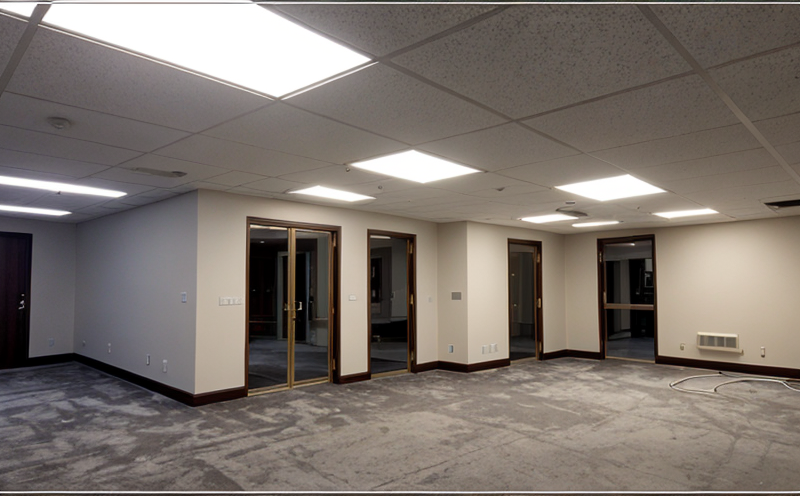EN 62471 Photobiological Safety Testing of Decorative Light Sources
The EN 62471 standard is a critical tool for ensuring the photobiological safety of decorative light sources. This standard, developed by CENELEC (European Committee for Electrotechnical Standardization), specifically addresses the photobiological risks associated with artificial lighting that are intended to be used in and around domestic or public spaces.
The standard is particularly important as it helps prevent potential health hazards related to overexposure to certain wavelengths of light, such as ultraviolet (UV) and blue light. The testing under EN 62471 aims to ensure that decorative lighting products do not emit harmful levels of radiation. This is achieved by measuring the spectral power distribution (SPD) of the light sources and comparing it against predefined safety limits.
The scope of this standard includes a wide range of decorative lighting fixtures, such as LED strips, chandeliers, wall sconces, and other types of lamps that are designed to enhance visual appeal or provide ambiance. It is essential for manufacturers, importers, and retailers who wish to comply with European Union regulations.
The testing process under EN 62471 involves several key steps. First, the specimen must be prepared according to specific instructions provided in the standard. This includes ensuring that the light source is in its intended operating condition, which may require powering up the fixture for a specified period before testing.
The next step is the measurement of the spectral power distribution (SPD) using specialized instrumentation capable of accurately measuring the intensity and wavelength distribution of the emitted light. This data is then compared against the safety limits prescribed in EN 62471 to determine if the product complies with the standard.
It is important to note that this testing process requires a high level of precision, as even minor deviations from the specified wavelengths or intensities can lead to non-compliance. The use of advanced photometric equipment and trained personnel ensures accurate results.
The EN 62471 standard also includes provisions for handling various types of light sources, including those that may emit multiple colors or have varying spectral outputs over time. This flexibility allows the standard to accommodate the diverse nature of modern decorative lighting products.
Compliance with EN 62471 is not only a matter of regulatory adherence but also a commitment to public safety and environmental responsibility. By ensuring that decorative light sources are photobiologically safe, manufacturers contribute to reducing health risks associated with overexposure to certain types of light.
The standard's application extends beyond mere compliance; it also serves as a benchmark for product design and development. Designers can use the insights gained from EN 62471 testing to create safer, more aesthetically pleasing lighting solutions that meet both functional and safety requirements.
Applied Standards
The primary standard applied in this service is EN 62471: Photobiological Safety of lamps and lamp systems. This European Standard was published by CENELEC (European Committee for Electrotechnical Standardization) to address the photobiological safety aspects of artificial lighting intended for use or placement in domestic, office, public spaces, or similar places.
EN 62471 establishes a safety framework that encompasses various types of lamps and lamp systems, including incandescent, fluorescent, LED, and other light-emitting diode-based products. The standard focuses on the potential risks from exposure to ultraviolet (UV) radiation, visible light, and infrared (IR) radiation.
The photobiological safety assessment under EN 62471 is conducted in accordance with ISO/IEC Guide 98-1:2008, which provides a general approach for the risk assessment of exposure to electromagnetic fields. This guide ensures that the testing methodology used aligns with internationally recognized practices.
| Standard | Description |
|---|---|
| EN 62471: Photobiological Safety of lamps and lamp systems | This standard provides the necessary criteria for the photobiological safety assessment of decorative light sources. |
Quality and Reliability Assurance
The quality and reliability assurance process in EN 62471 Photobiological Safety Testing involves multiple layers of verification to ensure that decorative light sources meet the required safety standards. This begins with meticulous specimen preparation, which includes ensuring that the lighting fixtures are powered up under controlled conditions.
Once prepared, the specimens undergo rigorous testing using state-of-the-art photometric equipment capable of accurately measuring the spectral power distribution (SPD) across a wide range of wavelengths. The data collected is then analyzed against predefined safety limits to determine compliance with EN 62471.
The reliability assurance process also involves regular calibration and validation of testing instruments to maintain accuracy and consistency. This ensures that all test results are reliable and reproducible, providing confidence in the overall quality of the tested products.
In addition to these technical measures, a robust quality management system is implemented to oversee the entire testing process. This includes detailed record-keeping, regular audits, and continuous improvement initiatives aimed at enhancing both the accuracy and efficiency of the testing procedures.
By adhering to this comprehensive approach, the laboratory ensures that it provides accurate, reliable, and consistent results in EN 62471 Photobiological Safety Testing. This commitment to quality is further reinforced by ongoing training for technical staff and staying updated with the latest developments in photometric technology.
Use Cases and Application Examples
| Use Case/Application Example | Description |
|---|---|
| LED Wall Decorations | Testing of LED wall decorations for use in public spaces such as shopping malls and airports. |
| Chandeliers | Photobiological safety assessment of chandeliers used in residential settings. |
| Led Strips | Testing of LED strips for use in home and office environments. |
| Wall Sconces | Photobiological safety evaluation of wall sconces used in residential or commercial spaces. |
| Recessed Lighting Fixtures | Assessment of recessed lighting fixtures for photobiological safety compliance. |
| Bathroom Decorative Lighting | Testing of decorative lighting specifically designed for bathrooms to ensure safe use. |





